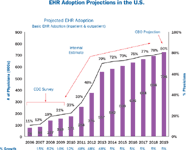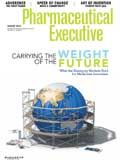An IOU to Big Pharma Regarding EHR
It's a work in progres among EHR providers to offer a clear bridge between pharma and physicians.
In the past, mentioning electronic health records (EHRs) to pharma industry marketing departments would mostly elicit, if anything, yawns and conversation-stoppers. They're too costly to install and maintain, and therefore most physician practices aren't using them. In 2008, when the Journal of the American Medical Informatics Association (JAMIA) published a case study from Pfizer's healthcare informatics group, which examined how EHRs might support business functions, the primary conclusions were that EHRs could potentially be valuable in some areas, such as drug safety and surveillance or clinical trial recruitment. The assumption was that EHRs could provide patient data and contribute to a more robust database for drug monitoring, but again, without widespread physician adoption, the benefits of EHRs for pharma seemed limited.
New Incentive
Then, in 2009, the Obama Administration earmarked a whopping $19.2 billion for EHRs as part of the American Recovery and Reinvestment Act (ARRA), and put new incentives in place for adoption; the Congressional Budget Office (CBO) estimates that healthcare information technology (HCIT) spending could top $36 billion. Under the well-known "meaningful use" provision of the ARRA, sticks have now emerged, in addition to the carrots, for EHR adoption and e-prescribing. Physician practices stand to receive up to $44,000 per physician over a five-year period if they adopt EHRs in 2011, direct from the Centers for Medicare & Medicaid Services (CMS). Penalties for non-adoption begin in 2015. Some physicians jumped on board soon after the incentive program was announced, but the vast majority did not. In 2009, approximately 153,000 physicians were using EHRs in their practice, and in 2010, that number increased to 171,000. Beginning this year, however, adoption rates are expected to grow exponentially, with 254,000 physicians using EHRs in 2011, and 376,000 in 2012. By 2013, roughly 70 percent of physicians, or 557,000, are expected to be using EHRs. The CBO predicts that 80 percent, or 726,000 physicians, will be using EHRs by 2019.
While the biggest providers of EHRs, such as Epic, Allscipts/Eclipsys, and NextGen, are well established, and medium-size players such as Cerner, Sage, Greenway, and AthenaHealth have made headway with early adopters, there haven't been, until recently, EHR providers that offer a clear way in for pharma.
"With the exception of Practice Fusion"—a free, ad-supported EHR provider—"there are no real pharma regulatory or marketing services available in electronic health records," says Ed Fotsch, CEO at PDR, publisher of the Physicians' Desk Reference, a drug reference service. "EHRs were developed ignoring the pharmaceutical industry." As sales forces shrink, and direct access to physicians becomes increasingly difficult, Fotsch says there's a need for the provision of basic services that physicians and pharmaceutical companies find valuable. "Whether you have a pharma regulatory goal or a marketing goal, either one requires engagement with physicians, ideally at the point of care," he says. To that end, a new crop of EHR providers such as Practice Fusion, PDR, and, most recently, Epocrates, are stepping up to the plate, in an attempt to give pharma marketers access to physicians, without disrupting their workflow. Fotsch, a physician, says "the traditional goal of pharma, when I was practicing, was to disrupt my workflow with pizzas, coupons, great-looking drug reps, and so on, and while that was pleasant, it didn't exactly help my patient volume throughput."

EHR Adoption Projections in the U.S.
Other parties, besides EHR providers, have recognized the value of EHRs. Hospitals are now actively purchasing EHR platforms for physician practices, assuming that a systems alignment between a physician group and a hospital will boost referrals—a safe bet, according to Fotsch. "If the EHR platforms are in sync, and really accessible, between a physician's office and the hospital, so that dictations, lab results, and so on can be freely exchanged, [the physician] is much more likely to refer to that hospital," he says. Hospitals such as Advocate in Chicago, Sisters of Charity of Health System in Cleveland, Long Island Jewish Medical Center in New York, and others have committed "tens of millions of dollars" to bolstering referral lines through EHR purchases, says Fotsch. Asked whether pharmaceutical companies could see a positive ROI on purchasing EHRs for doctors, Fotsch says part of the reason that pharma has been left out of EHR design to date is that pharma "can't legally give away EHRs; that would be a broad inurement issue."
Do Not Disturb
With EHRs, disruption of a physician's "chat, chart, and charge" workflow is unnecessary, says Fotsch. Physicians will use EHRs during an exam with patients, and if they can find valuable services one click away, or embedded within the EHR technology—easy access to patient education materials, coupons and other financial assistance, or samples—they'll use them, or their office managers and nurses will use them. Rose Crane, CEO at Epocrates, is also targeting the physician's workflow with that company's EHRs. Crane says the four criteria used by Epocrates when developing its EHRs were affordability, ease of use, a focus on the patient encounter for the physician-facing template, and uninterrupted workflow. "We are admittedly coming late to the [EHR] market, but I'd say that we've learned from a lot of the current EHR providers out there, and what physicians find problematic," says Crane. Epocrates announced the first phase of its EHR roll-out on July 27. The company will target small physician practices, rather than compete with the companies mentioned above.
The other major development within the new crop of EHR providers is access: PDR and Epocrates, both of which made their bones initially as a drug reference for physicians, have kept up with shift in technology platforms used by physicians, beginning with smartphones and now tablets. As such, the companies' EHR offerings utilize mobile and SAAS technology, which lets physicians bypass much, if not all, of the hardware installation, a key barrier to adoption. Additionally, drug updates, such as black box warnings, risk, and REMS information, are updated live in real-time. "The fact that box warnings aren't surfaced real-time in EHRs, and that EHRs don't contain the full updated FDA-approved labeling, is kind of astounding," says Fotsch, adding that with EHRs only recently being underwritten by the federal government, it's perhaps not entirely astounding. After talks with FDA in April, PDR, with its partners, launched an adverse events reporting service in June, which is incorporated into the EHR platform. Fotsch says physicians don't have time to report every adverse event they encounter with patients through the traditional channels, which is typically a phone call to a pharmaceutical company. In her keynote address at the PDR-sponsored PharmEHR Summit last April, Janet Woodcock, director of the Center for Drug Evaluation and Research (CDER) at FDA, advocated for not only adverse events reporting through EHRs, but also talked about incorporating REMS programs into EHRs. "REMS are very clunky, and not well integrated into the physician's workflow ... I think [REMS] can be integrated into the workflow through EHRs and electronic prescribing, and can have much more value for everyone." Woodcock said EHRs can provide a fail-safe for prescribers: "You shouldn't get your warfarin refilled for the first time if you haven't had an INR test in the intervening month," for example. It would also be useful, said Woodcock, to provide pharma-sponsored support services like financial assistance through EHRs.
It's important for brands to "skate toward the puck," in terms of creating a strategy for EHRs, says Fotsch. Pharma companies that get involved now can say, "Here are my samples, coupons, copay cards, warnings, etc., and they're available within your EHR, and my competitor has nothing," says Fotsch.

Is Artificial Intelligence a ‘Product’? Products Liability Implications for AI-Based Products
April 10th 2025As the physical products we use evolve to become increasingly complex, traditional products liability frameworks may not always fit to provide remedies for harm that can result from using novel product types.